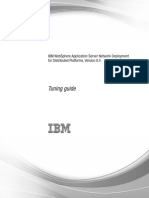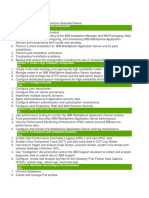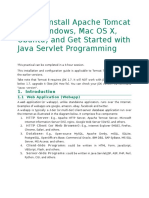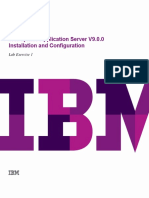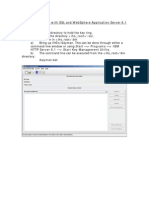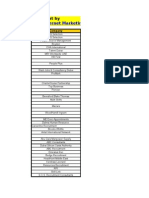WebSphere Q & As
WebSphere Q & As
Uploaded by
LaeeqSiddiquiCopyright:
Available Formats
WebSphere Q & As
WebSphere Q & As
Uploaded by
LaeeqSiddiquiCopyright
Available Formats
Share this document
Did you find this document useful?
Is this content inappropriate?
Copyright:
Available Formats
WebSphere Q & As
WebSphere Q & As
Uploaded by
LaeeqSiddiquiCopyright:
Available Formats
What is WebSphere?
WebSphere refers to a brand for IBM software products. It is designed for setting up, operation and integration of electronic business applications. These applications could perform well on cross platform environment. These set of software are java based web technologies.
What is WebSphere?
WebSphere is a set of Java-based tools from IBM that allows customers to create and manage sophisticated business Web sites.
Explain the architecture of Web Sphere.
WebSphere architecture consists of one or more computer systems which are called nodes. Nodes are available within WebSphere cell. A WebSphere cell can have one node. On this node all the needed softwares installed. If a WebSphere cell contains more than one node, then all the software components are distributed among the nodes. The software components that are installed in one node can share in the distributed environment. This distribution enables for scalability, reliability. The following are the components:
A web server which provides the services of HTTP A database server for data persistence WebSphere Application Server (WAS)
Explain the architecture of Web Sphere.
The WebSphere HTTP plug-in architecture has the following characteristics:
The Web server plug-in is implemented as a filter, which examines all incoming HTTP requests and routes them to other Web servers based on the composition of the URL. Each Web server has its own API that allows filters to be implemented. Standards-based protocols (HTTP/S) that are supported by firewall products are used. SSL can be used within the DMZ to encrypt network traffic between the Web server and the application server. The configuration file used by the plug-in is XML-based, and easy to administer. Multiple redirection rules may be defined to one or more application servers as dictated by the topology chosen. The plug-in supports load balancing and failover capabilities, which offer further scalability with very little additional administrative effort.
State some of the features present in web sphere.
The following are the features of WebSphere:
Suports the Servlet/JSP container functionality which runs on top of HTTP. Supports HTTP servers such as IBM HTTP server, MS IIS and Netscape iPlanet server. Supports HTML pages, Setvlets, Java Server Pages and XML. Supports EJB component model, Workload Management. WLM supports multiple servers within a single administrative domain.
State some of the features present in web sphere.
WebSphere applications use the following kinds of technologies:
Java specifications and other open standards for developing applications WebSphere programming model extensions to enhance application functionality Containers and services in the application server, used by deployed applications, and which sometimes can be extended
What is extended deployment in Web Sphere?
WebSphere Extended Deployment is a new product for IBM WebSphere software. WED extends the WebSphere software platform. The new features / notions include dynamic operations, high performance computing and extended management.
What is extended deployment in Web Sphere?
WebSphere Extended Deployment delivers enhanced Qualities of Service with features for optimizing IT resources. The suite comprises of 3 products: 1. WebSphere Virtual Enterprise:
It increases flexibility and agility to ensure business process integrity, improve service, application performance, and better manage health. It provides application infrastructure virtualization capabilities that lower costs required to create, manage, and run enterprise applications and an SOA environment.
2. WebSphere eXtreme Scale:
It is an essential IBM software technology for conducting extreme transaction processing. It allows business applications to process exceptionally large volumes of transactions with extreme efficiency and linear scalability. It provides transactional integrity and transparent failover to ensure high availability, high reliability, and constant response times. It operates as an in-memory data grid that dynamically caches, partitions, replicates, and manages application data and business logic across multiple servers.
3. Compute Grid:
Enables the scheduling, execution and monitoring of batch type jobs with enhanced service policy and workload management
What is Web sphere MQ JMS Provider?
The usage of WebSphere MQ is employed to use as Java Message Service provider for JEE applications which are deployed in WebSphere Application Server. The WebSphere MQ JMS is message service provider for WebSphere MQ systems. It is a set of Java classes. These classes allow the usage of JMS applications to access WebSphere MQ systems. The models point-to-point and publish/subscribe of JMS are supported by MQ JMS provider.
Explain the attribute CHANNEL in web sphere MQ.
A channel is a connection that is to establish a link between sending channel and receiving channel. A channel has a sender channel at the local queue manager and receiver channel at the remote queue manager. These two channels consist of same name, and together make one channel. The CHANNEL attribute is used with WebSphere MQ applications to specify the channels for receiving and sending messages in a file that defines sender and receiver channels.
Explain about web sphere MQ Real time transport.
It is a lightweight protocol. This protocol is optimized for use with messages that are non-persistent. WebSphere MQ Real Time Transport is utilized only by JMS clients. WebSphere MQ Real Time Transport is right suitable for the applications to send large number of messages. All the applications that use this protocol must rely on TCP/IP for quality considerations and which do not require persistent delivery. For example, this protocol can be used in situations where the data is updated very frequently, such as stock market share values, updating scoreboard of a sporting event.
Explain about web sphere MQ Real time transport.
WebSphere MQ Real-time Transport is a lightweight protocol optimized for use with nonpersistent messaging. It is used by JMS clients, and provides high levels of scalability and message throughput. WebSphere MQ Real-time Transport is ideal for applications where large numbers of messages need to be sent or where messages need to be sent to large numbers of client applications. The WebSphere MQ Real-time Transport does not provide any facilities for persistent messaging or durable subscriptions.
You might also like
- Vlocity OmniStudio DocumentationDocument2,135 pagesVlocity OmniStudio Documentationdamdam80% (5)
- Lab10 - DirbusterDocument15 pagesLab10 - DirbusterSaw GyiNo ratings yet
- Cold Email Mastery Course - From Cold To Gold 2019Document116 pagesCold Email Mastery Course - From Cold To Gold 2019Andrei GrozaNo ratings yet
- IBM Websphere Application Server Interview QA: WebserverDocument3 pagesIBM Websphere Application Server Interview QA: WebserverGolden_PeacockNo ratings yet
- What Is WASDocument118 pagesWhat Is WASArunSiddesh KBNo ratings yet
- IBM Certified WAS 8.5 Administrator ArchitectureDocument43 pagesIBM Certified WAS 8.5 Administrator ArchitectureMu'ath BaioudNo ratings yet
- Ibm Websphere Application Server Interview QuestionsDocument10 pagesIbm Websphere Application Server Interview QuestionsPrashant PurwarNo ratings yet
- Was8.5 DumpsDocument33 pagesWas8.5 DumpsSathish PillaiNo ratings yet
- What Is WASDocument108 pagesWhat Is WASSiddik AhmedNo ratings yet
- Open LibertyDocument46 pagesOpen LibertyJesus JacobeNo ratings yet
- Migrating Websphere App Server 6.1 To 8.5Document5 pagesMigrating Websphere App Server 6.1 To 8.5MafortNo ratings yet
- Ibm Webshere Application Server Vertical ClusteringDocument34 pagesIbm Webshere Application Server Vertical ClusteringfilenetdirectorNo ratings yet
- GSK Error Bad CertDocument4 pagesGSK Error Bad CertLalith MallakuntaNo ratings yet
- Notes For WebSphere8.5 Administration Udemy v1Document30 pagesNotes For WebSphere8.5 Administration Udemy v1SPAL BROTHERNo ratings yet
- Deploy Application On Oracle WebLogic ServerDocument27 pagesDeploy Application On Oracle WebLogic ServerahsumonbdNo ratings yet
- WA5912G08 OutOfMemoryDocument74 pagesWA5912G08 OutOfMemorypmdariusNo ratings yet
- ClusteringDocument43 pagesClusteringJambala RfdfdNo ratings yet
- Was85nd TuningDocument97 pagesWas85nd TuningManuel Gomez FredesNo ratings yet
- SSL Over WebSphereDocument16 pagesSSL Over WebSphereAnkit Poddar100% (1)
- WebSphere Application Serrver v8 Installation LabDocument5 pagesWebSphere Application Serrver v8 Installation LabBrahma BotlaguntaNo ratings yet
- Websphere HA On Distributed PlatformsDocument82 pagesWebsphere HA On Distributed PlatformsHilal MikatiNo ratings yet
- Weblogic Interview QuestionsDocument4 pagesWeblogic Interview Questionsharshvardhan05No ratings yet
- Wsadmin Objects - Ibm Was Interview AnswersDocument4 pagesWsadmin Objects - Ibm Was Interview AnswersSvr RaviNo ratings yet
- IBM WebSphere Application Server Interview QuestionsDocument19 pagesIBM WebSphere Application Server Interview QuestionsdsbrNo ratings yet
- Websphere v9Document3 pagesWebsphere v9Thirumala KakaniNo ratings yet
- Tomcat Cluster SetupDocument3 pagesTomcat Cluster SetupsmjainNo ratings yet
- Weblogic Server Overview - Topology Configuration AdministrationDocument36 pagesWeblogic Server Overview - Topology Configuration AdministrationMurali PalepuNo ratings yet
- Ibmmqhaanddr: Project Name: IBM MQ Installation and Configuration MQ v8 or v7.5 HA and DR DocumentDocument9 pagesIbmmqhaanddr: Project Name: IBM MQ Installation and Configuration MQ v8 or v7.5 HA and DR DocumentMinh GiaNo ratings yet
- MQ Interview QuestionsDocument65 pagesMQ Interview QuestionsBabu ReddyNo ratings yet
- App Connect Enterprise Certified Containerin CP4 IDocument44 pagesApp Connect Enterprise Certified Containerin CP4 IDaryNo ratings yet
- Weblogic AdminDocument23 pagesWeblogic AdminNikhil LuthraNo ratings yet
- Apache Tomcat 8 Application ServerDocument11 pagesApache Tomcat 8 Application Serverarm_max78No ratings yet
- Weblogic Interview Q&ADocument6 pagesWeblogic Interview Q&Araguram_govindarajNo ratings yet
- Ih03 Rfhutil EtcDocument87 pagesIh03 Rfhutil EtcjumboaimNo ratings yet
- Load Balancing Interview QuestionsDocument18 pagesLoad Balancing Interview QuestionsPhillipNo ratings yet
- Best 48 Jboss Interview Questions and AnswersDocument13 pagesBest 48 Jboss Interview Questions and AnswersfernandojhNo ratings yet
- IBM APIConnect v10.x - Whitepaper - v1.4Document80 pagesIBM APIConnect v10.x - Whitepaper - v1.4thienxuNo ratings yet
- How To Configure Proxy If Multiple Manager Servers Are There in Cluster? Where Will You Check Whether The Cluster Is Load Balancing The Request?Document2 pagesHow To Configure Proxy If Multiple Manager Servers Are There in Cluster? Where Will You Check Whether The Cluster Is Load Balancing The Request?Naresh KumarNo ratings yet
- How To Install Apache Tomcat 8Document52 pagesHow To Install Apache Tomcat 8Sachin KuchhalNo ratings yet
- Websphere Plugin Detailed PDFDocument53 pagesWebsphere Plugin Detailed PDFharshad27No ratings yet
- Weblogic Interview Prep (AutoRecovered)Document19 pagesWeblogic Interview Prep (AutoRecovered)SachinNo ratings yet
- Wsadmin MainDocument14 pagesWsadmin MainprathapnaiduNo ratings yet
- Configuring Tomcat With Apache or IIS For Load BalancingDocument9 pagesConfiguring Tomcat With Apache or IIS For Load BalancingGeorge AnadranistakisNo ratings yet
- WebSphere DataPower SOA Appliances and XSLT Part 1Document23 pagesWebSphere DataPower SOA Appliances and XSLT Part 1Gema Alcolado AyusoNo ratings yet
- BEA WebLogic Interview Questions and AnswersDocument60 pagesBEA WebLogic Interview Questions and AnswerskalimireddyNo ratings yet
- Was Interview QuestionsDocument24 pagesWas Interview QuestionsSri ShailamNo ratings yet
- WebsphereDocument34 pagesWebsphereVenu Gopal VegiNo ratings yet
- Multi Protocol Gateway Developers GuideDocument416 pagesMulti Protocol Gateway Developers Guidenaveen25417313No ratings yet
- L01 WAS85 Liberty GettingStarted V1.4Document55 pagesL01 WAS85 Liberty GettingStarted V1.4progixNo ratings yet
- WAS9 Admin PoT Lab1 - Installation&Configuration v1.2Document47 pagesWAS9 Admin PoT Lab1 - Installation&Configuration v1.2weblogicfans中文爱好者No ratings yet
- Configuring Apache HTTP Server and Tomcat With Mod JKDocument3 pagesConfiguring Apache HTTP Server and Tomcat With Mod JKPravin UttarwarNo ratings yet
- Web LogicDocument36 pagesWeb LogicChiranjeeviChNo ratings yet
- SSL Config Was61 IhsDocument17 pagesSSL Config Was61 IhsEsteban Adrian Lopez FajardoNo ratings yet
- Different Types Queues in Websphere MQDocument3 pagesDifferent Types Queues in Websphere MQchirutha84100% (1)
- Practice Test: Updated: Oct 1, 2009Document36 pagesPractice Test: Updated: Oct 1, 2009Ramakrishna MovvaNo ratings yet
- Red Hat JBoss Enterprise Application Platform-7.0Document81 pagesRed Hat JBoss Enterprise Application Platform-7.0JavedNo ratings yet
- Installing Apache Tomcat On LinuxDocument7 pagesInstalling Apache Tomcat On LinuxAbbaq NadeemNo ratings yet
- Answers For MQ Interview QuestionsDocument4 pagesAnswers For MQ Interview QuestionschlaxmikanthNo ratings yet
- Module Web LayoutDocument2 pagesModule Web LayoutXI TKJ 2 - Akhmad Galang SNo ratings yet
- Cambridge IGCSE: Computer Science 0478/12Document12 pagesCambridge IGCSE: Computer Science 0478/12Prabhav MathurNo ratings yet
- Netcool/Impact Policy Reference Guide 6.1Document206 pagesNetcool/Impact Policy Reference Guide 6.1tmiessaNo ratings yet
- UNIT 6 React JSDocument17 pagesUNIT 6 React JSAdfar RashidNo ratings yet
- Industrial Training PPT PDF (2nd Year)Document24 pagesIndustrial Training PPT PDF (2nd Year)scientistmayankagarwal1No ratings yet
- Lesson 2 Notes and VocabularyDocument6 pagesLesson 2 Notes and Vocabularyapi-241878609No ratings yet
- Chapter 06: Computer Networks: "Digital Hub (Center of Our Universe) Is Moving From PC To Cloud" Steve JobsDocument16 pagesChapter 06: Computer Networks: "Digital Hub (Center of Our Universe) Is Moving From PC To Cloud" Steve JobsKevin JohnstonNo ratings yet
- DRG Configuration - Swiping and FaxDocument10 pagesDRG Configuration - Swiping and Faxapi-3743401100% (3)
- FAQ About Virtual Assistants-SGBDocument11 pagesFAQ About Virtual Assistants-SGBAprinaNo ratings yet
- Fortiadc: Application Delivery ControllersDocument16 pagesFortiadc: Application Delivery ControllersKunalNo ratings yet
- Multiple States File Antitrust Lawsuit Against GoogleDocument115 pagesMultiple States File Antitrust Lawsuit Against GoogleGizmodo EditNo ratings yet
- Food Delivery Cause-ConnectDocument48 pagesFood Delivery Cause-ConnectYOGENDRANo ratings yet
- CloudComputing Day3 Actual enDocument7 pagesCloudComputing Day3 Actual enjansonalbi172002No ratings yet
- Facebook Font Generator - ????????Document1 pageFacebook Font Generator - ????????Zé SilvaNo ratings yet
- Test Made by PriyankaDocument5 pagesTest Made by PriyankaPawan SainiNo ratings yet
- Headhunters in DubaiDocument6 pagesHeadhunters in DubaiPedro Neira100% (8)
- WebSphere With A Side of SPNEGO V4Document63 pagesWebSphere With A Side of SPNEGO V4Ali KhanNo ratings yet
- Sodoso - Assessment 2 - GEC124 - LAA1Document5 pagesSodoso - Assessment 2 - GEC124 - LAA1Wench Ryechelle SodosoNo ratings yet
- NCVT Mis FaqDocument5 pagesNCVT Mis FaqER Hariram PrajapatNo ratings yet
- Introduction To WWWDocument76 pagesIntroduction To WWWArman KoriNo ratings yet
- Dental ThesisDocument65 pagesDental ThesisHiro HayashiNo ratings yet
- OpenHAB Version Update - Letter Box Alert SystemDocument5 pagesOpenHAB Version Update - Letter Box Alert SystemJosepMencionSeguranyesNo ratings yet
- Vulnerabiliades - DiccionarioDocument142 pagesVulnerabiliades - DiccionarioJohan MorilloNo ratings yet
- Automation ExerciseDocument14 pagesAutomation ExercisePallavi SagarNo ratings yet
- Lesson 1 Intro. To IctDocument34 pagesLesson 1 Intro. To IctANGEL GWYNET RIEGONo ratings yet
- How To Use Quora To Increase Your Business ExposureDocument103 pagesHow To Use Quora To Increase Your Business ExposureSuhailHaqueNo ratings yet
- Digital Marketing TabrezDocument116 pagesDigital Marketing Tabreztanzeelakownain16No ratings yet



















